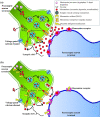Marine algae as emerging therapeutic alternatives for depression: A review
- PMID: 34804417
- PMCID: PMC8591755
- DOI: 10.22038/ijbms.2021.54800.12291
Marine algae as emerging therapeutic alternatives for depression: A review
Abstract
Depression is a complex heterogeneous brain disorder characterized by a range of symptoms, resulting in psychomotor and cognitive disabilities and suicidal thoughts. Its prevalence has reached an alarming level affecting millions of people globally. Despite advances in current pharmacological treatments, the heterogenicity of clinical response and incidences of adverse effects have shifted research focus to identification of new natural substances with minimal or no adverse effects as therapeutic alternatives. Marine algae-derived extracts and their constituents are considered potential sources of secondary metabolites with diverse beneficial effects. Marine algae with enormous health benefits are emerging as a natural source for discovering new alternative antidepressants. Its medicinal properties exhibited shielding efficacy against neuroinflammation, oxidative stress, and mitochondrial dysfunction, which are indicated to underlie the pathogenesis of many neurological disorders. Marine algae have been found to ameliorate depressive-like symptoms and behaviors in preclinical and clinical studies by restoring monoaminergic neurotransmission, hypothalamic-pituitary-adrenal axis function, neuroplasticity, and continuous neurogenesis in the dentate gyrus of the hippocampus via modulating brain-derived neurotrophic factors and antineuroinflammatory activity. Although antidepressant effects of marine algae have not been validated in comparison with currently available synthetic antidepressants, they have been reported to have effects on the pathophysiology of depression, thus suggesting their potential as novel antidepressants. In this review, we analyzed the currently available research on the potential benefits of marine algae on depression, including their effects on the pathophysiology of depression, potential clinical relevance of their antidepressant effects in preclinical and clinical studies, and the underlying mechanisms of these effects.
Keywords: Antidepressants; Complementary medicine; Depression; Microalgae; Neuroinflammation; Neuronal plasticity; Seaweed.
Conflict of interest statement
The authors declare no conflicts of interest, financial or otherwise.
Figures





Similar articles
-
An Update on Potential Antidepressants Derived from Marine Natural Products.Cent Nerv Syst Agents Med Chem. 2023;23(2):71-85. doi: 10.2174/1871524923666230825105035. Cent Nerv Syst Agents Med Chem. 2023. PMID: 37622698 Review.
-
Neuroplasticity-related mechanisms underlying the antidepressant-like effects of traditional herbal medicines.Eur Neuropsychopharmacol. 2017 Oct;27(10):945-958. doi: 10.1016/j.euroneuro.2017.07.008. Epub 2017 Aug 12. Eur Neuropsychopharmacol. 2017. PMID: 28807619 Review.
-
Stress, serotonin, and hippocampal neurogenesis in relation to depression and antidepressant effects.Neurosci Biobehav Rev. 2014 Jan;38:173-92. doi: 10.1016/j.neubiorev.2013.11.009. Epub 2013 Dec 1. Neurosci Biobehav Rev. 2014. PMID: 24300695 Review.
-
The hippocampus, neurotrophic factors and depression: possible implications for the pharmacotherapy of depression.CNS Drugs. 2011 Nov 1;25(11):913-31. doi: 10.2165/11595900-000000000-00000. CNS Drugs. 2011. PMID: 22054117 Review.
-
Potential effect of herbal antidepressants on cognitive deficit: Pharmacological activity and possible molecular mechanism.J Ethnopharmacol. 2020 Jul 15;257:112830. doi: 10.1016/j.jep.2020.112830. Epub 2020 Apr 4. J Ethnopharmacol. 2020. PMID: 32259666 Review.
Cited by
-
Malaysian brown macroalga Padina australis mitigates lipopolysaccharide-stimulated neuroinflammation in BV2 microglial cells.Iran J Basic Med Sci. 2023;26(6):669-679. doi: 10.22038/IJBMS.2023.67835.14842. Iran J Basic Med Sci. 2023. PMID: 37275754 Free PMC article.
-
Natural sulfur compounds in mental health and neurological disorders: insights from observational and intervention studies.Front Nutr. 2025 Apr 9;12:1534000. doi: 10.3389/fnut.2025.1534000. eCollection 2025. Front Nutr. 2025. PMID: 40271431 Free PMC article. Review.
-
Spirulina platensis Suppressed iNOS and Proinflammatory Cytokines in Lipopolysaccharide-Induced BV2 Microglia.Metabolites. 2022 Nov 20;12(11):1147. doi: 10.3390/metabo12111147. Metabolites. 2022. PMID: 36422287 Free PMC article.
-
Sargassum horneri Extract Attenuates Depressive-like Behaviors in Mice Treated with Stress Hormone.Antioxidants (Basel). 2023 Oct 10;12(10):1841. doi: 10.3390/antiox12101841. Antioxidants (Basel). 2023. PMID: 37891920 Free PMC article.
-
Potential antidepressant effects of a dietary supplement from the chlorella and lion's mane mushroom complex in aged SAMP8 mice.Front Nutr. 2022 Sep 2;9:977287. doi: 10.3389/fnut.2022.977287. eCollection 2022. Front Nutr. 2022. PMID: 36118772 Free PMC article.
References
-
- World Health Organization. Depression and other common mental disorders: global health estimates. Switzerland: World Health Organization: Geneva; 2017.
-
- Wong SK, Chin KY, Ima-Nirwana S. Vitamin D and depression: the evidence from an indirect clue to treatment strategy. Curr Drug Targets. 2018;19:888–897. - PubMed
-
- GBD 2017 Disease and Injury Incidence and Prevalence Collaborators. Global, regional, and national incidence, prevalence, and years lived with disability for 354 diseases and injuries for 195 countries and territories, 1990-2017: a systematic analysis for the Global Burden of Disease Study 2017. Lancet. 2018;392:1789–1858. - PMC - PubMed
-
- Institute for Public Health. National Health and Morbidity Survey (NHMS) 2019: non-communicable diseases, healthcare demand and health literacy-key findings (pp 21-22). Selangor, Malaysia: National Institutes of Health (NIH) Malaysia: National Institutes of Health (NIH); 2020.
-
- Indu PS, Anilkumar TV, Pisharody R, Russell PSS, Raju D, Sarma PS, et al. Prevalence of depression and past suicide attempt in primary care. Asian J Psychiatr. 2017;27:48–52. - PubMed
Publication types
LinkOut - more resources
Full Text Sources
